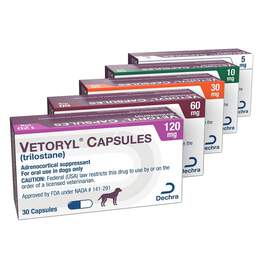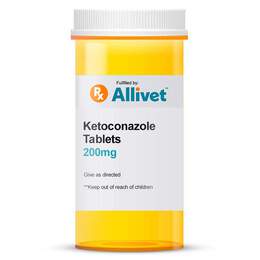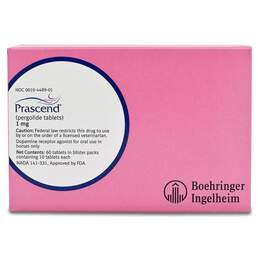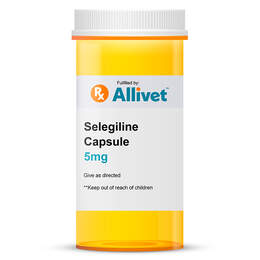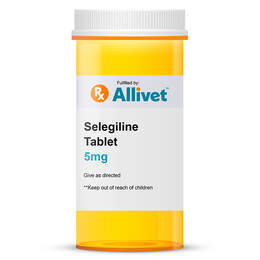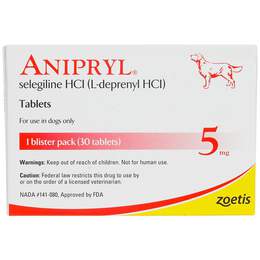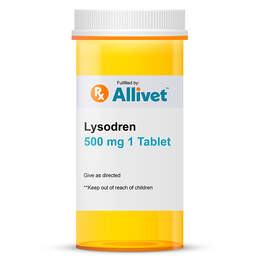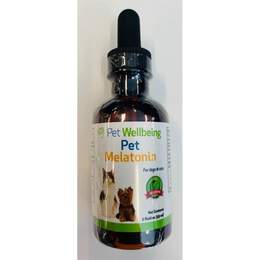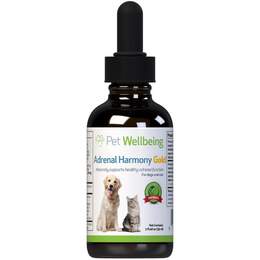Cushing's Disease
Related Categories
What Is Cushing's Disease in Animals?
Cushing disease in animals (also called Cushing's syndrome) refers to a condition where an animal's adrenal glands produce too much of some hormones, in this case, cortisol. Too much or too little production of cortisol can be life-threatening. The medical term for the disease is hyperadrenocorticism in dogs and cats and Pituitary Pars Intermedia Dysfunction (PPID) in horses.
What Causes Cushing's Disease?
The cause of Cushing's disease depends on whether the animal affected is a dog, cat, or horse. While this disease is always a condition that results in the overproduction of cortisol, the reasons for that overproduction vary in each species.
Causes of Cushing's Disease in Dogs
Identifying the cause is key in determining treatment and the prognosis of the disease. Below are the three causes of Cushing's disease in dogs.
Pituitary Gland Tumor
Pituitary gland tumors cause approximately 85-90% of Cushing's disease cases in dogs. The tumor may be malignant (cancerous) or benign (harmless). Located at the base of the brain, the pituitary gland governs the production of hormones in the dog's body, including those produced by the adrenal glands, such as cortisol. The tumor causes the pituitary gland to produce too much of the hormone that triggers the adrenal glands to produce cortisol, resulting in overproduction.
If the overproduction of cortisol by the adrenal glands can be managed, many dogs with this type of Cushing's disease often live normal lives as long as they take their Cushing's disease medication.
Adrenal Gland Tumor
A malignant or benign tumor on the adrenal glands themselves can also cause Cushing's disease. Surgical removal of the tumor can cure the disease.
Iatrogenic Cushing's Disease
In some instances, Cushing's disease is caused by long-term use of steroids, either oral or injectable. These steroids are usually given to control a different condition, but over time can become harmful.
Causes of Cushing's Disease in Cats
Cushing's disease is rare in cats and is most often caused by an abnormality of the pituitary gland or an abnormality of the adrenal glands. Alternatively, it can also be caused by long-term use of high doses of cortisol-like hormones, a treatment that can be necessary to control some diseases.
Causes of Cushing's Disease in Horses
As mentioned above, Cushing's disease in horses is more accurately known as PPID. It is an array of symptoms caused by the excess production of pituitary hormones. It is more common in older horses and ponies and is a common disease in equines of all ages. Increasing age is the primary risk factor.
Symptoms of Cushing's Disease
Regardless of the cause of Cushing's disease, the clinical symptoms are the same. The most commons signs include:
- Increased appetite
- Increased water consumption
- Increased urination
- Pot-bellied appearance
- Lethargy
- Muscle weakness
- Hair loss
- Poor coat condition
- Bruising
- Panting (dogs only)
- Thin and fragile skin (especially cats)
- Curling of the ear tips (cats)
- Failure or late shedding of the winter coat, shaggy coat (horses)
- Excessing sweating (horses)
- Loss of topline muscle (horses)
- Regional fat deposits above the eyes, above the tail, and the crest of the neck (horses)
- Laminitis (horses)
- Slow wound healing, susceptibility to internal parasites, increased skin infections
About 10% of dogs with Cushing's disease are diabetic; however, almost 80% of cats have diabetes mellitus and insulin resistance.
Treatment for Cushing's Disease
Because there are several causes of Cushing's disease, the treatment will vary depending on which type is present.
Pituitary Tumor
This form of Cushing's disease is the most complicated to treat. Two types of Cushing's disease mediations are commonly used: trilostane and mitotane. The main and only FDA-approved drug used to treat both pituitary and adrenal types of Cushing's disease is Vetoryl (trilostane). Mitotane is a chemotherapy drug for humans that destroys the layers of the adrenal gland that produce cortisol. This prescription is “off-label,” meaning vets can legally prescribe human drugs to animals and at different dosages than those listed on the label.
Selegiline hydrochloride and ketoconazole are also used to treat Cushing's disease in dogs, but they are not considered as effective as the other two.
Adrenal Tumor
One mode of treatment for an adrenal tumor is surgery, however, this is major abdominal surgery. If it is successful and the tumor is not malignant, the dog will most likely return to normal health. In cases where surgery is not an option, patients may be managed with the Cushing's disease medications discussed above.
Iatrogenic Cushing's Disease
Because steroid administration is the cause of this form, steroids must be discontinued. However, this must be done in a gradual, controlled way, under the supervision of a veterinarian to help keep other complications from occurring. It usually results in the return of the disease that the steroids were treating. In addition, since the steroid may have caused damage to the adrenal glands, treatment may be required to replace the hormones the adrenal glands usually produce.
Treatment of Equine Cushing's Disease (PPID)
Horses with PPID are put on the prescription drug pergolide, available as Prascend®. This brand is the first and only FDA-approved treatment for control and management of PPID's clinical signs and to improve the horse's quality of life, but may not extend their lifespan. This drug does not cure the disease. However, it does slow its progression and reduce the clinical symptoms, even the changes in muscle and hair coat.
Starting a horse with PPID on prescription medication as soon as possible after their diagnosis can help lessen the risks of serious medical issues such as laminitis, ligament and tendon injury, and recurring infections, to name just a few.
Some horses begin to show improvement with reduced clinical symptoms as soon as one month after starting to take Prascend, although others require two to three months to see beneficial changes. Your horse's veterinarian will closely monitor your horse's case and advise you when it is time to do a blood test to see whether or not the medication is having an internal effect as well.
Owners should let their veterinarian know if they see any side effects of pergolide, such as lack of appetite. This is a common adverse reaction, and there is an established method for getting horses back on feed and back on their medication.
Your veterinarian will develop a treatment plan for your pet's specific condition. Follow the veterinarian's guidelines closely, as the efficacy of these treatments relies on the consistent and regular administration of the drug. For some pets, lifelong treatment might be necessary.


